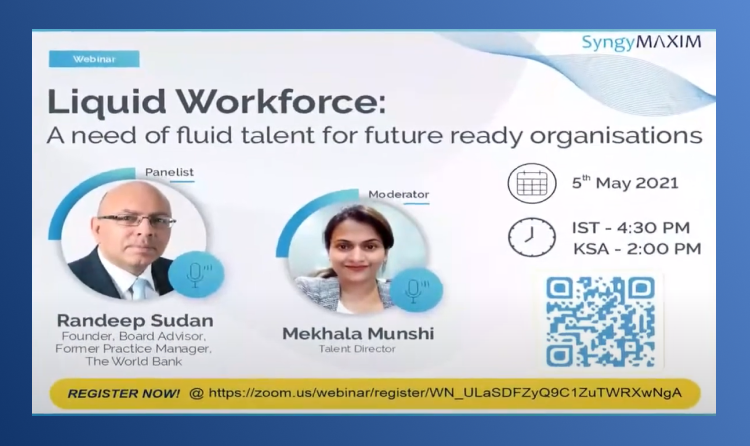
A Big Thank you to Mr. Randeep Sudan and Mekhala Munshi for giving us such important insights about liquid workforce.
The concept of the liquid workforce was first coined by Accenture in 2016, and the idea is essential that with the accelerating technology with changing business models, and with so much disruption taking place in labor markets, it will be important for the workforce to be liquid, in order to adapt the changing needs of the future market. Changing demands for skills is expecting workforces to be able to be very agile and very adaptive. Reskilling, upskilling and keep skilling that’s the whole idea about liquid workforce. As liquid adapts all the conditions and changes its forms that is what is expected with the human resources now.
Let's look at the future and see if you are to make your workforce liquid what would it entail. So, one thing which would be very important is that we would need to understand what are the trending skills and more importantly where is the demand trending. Unless we understand the skill trends completely and what skills sets, we need to have in order to float in the organizational requirements, it will be difficult to impart those skills and have a liquid workforce. So, how do you understand the trends in the labor market, here our speaker mentions about certain approaches those have been tried by companies like Burning Glass which is a Boston based company, other one EMSI which is also a US-based company that is foxing on the labor market and there is a company in Singapore called Jobcred. We need to know the skill analytics around labor markets to understand where skills are heading.
The supply-side challenge for tertiary education, Mr. Randeep Sudan mentioned that the work of educational institutions is becoming more and more difficult. He said according to Deloitte, technical skills now have a half-life of about 2 years. To see that we can develop the skills and do it in a personalized way, one very important thing is Digital Credentialing. Mr. Sudan added according to PWC, Employees can be trained faster using VR rather than traditional classrooms, the report says that the employees were 275% more confident in applying their skills learned after training. Walmart has used VR for training its employees in advance of Black Friday.
Organizations need to understand what type of skills do they need in the future to prepare themselves, there are quite a few companies that started specializing in understanding what are the existing skills in an organization and how those skills should be developed so that the companies could grow. 70% of Organizations are now focused on internal recruiting because they find workers are more appreciative and there is higher retention of workers to make the better workforce for the better outcome.
While talking about Gig Economy he said the recent study of Michael Dell foundation along with BCG, the potential for Gig economy in India in the long term is 90 million jobs, this could mean revenue of 250 billion dollars and an increment of 1.25% of GDP, to realize this opportunity we need to have a whole of government approach. The latest economic survey mentioned that there is movement in terms of the amendment on the code of social security, this code combines few laws and brings it under one umbrella which also specifies that workers under Gig economy should be considered as unorganized workers and social security benefits must be provided to them, and lot more has to be done. Health insurance of the gig economy workers must be adequately addressed. Spanish govt discussed with the employers and decided they will install algorithmic transparency so that the worker could know why he/she has been rejected.